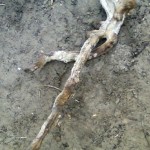The Research Design chapter made more sense after some time in the bush. It begins:
Relationships are reality
Indigenous scholar, Shawn Wilson (2009, p. 87) explains that in Indigenous research methodology, ‘Knowledge itself is held in the relationships and connections formed with the environment that surrounds us’. Wilson’s co-researcher, Lewis, explains this paradigm in terms of a circular structure that connects people to the places they occupy, where
land is another word for place, environment, your reality, the space you’re in … Indigenous is another word for human being … following not cultural norms but following foundational structures that are common to each other like the circle … the Indigenous world view [is] egalitarian, it’s relational, it’s a structure that supports an inclusion, a wholeness’. (2009, p. 92, 88)
The circle describes structures that exist within governmental and spiritual practices of Indigenous peoples around the world (Wilson, 2009; Atkinson, 1956.; Doring, 2000). The circle is one of the first forms to trace human gestures, and the gestures of our genetic ancestor, the Great Ape (Watts, 1977). As a form regulated by the structure of the body, the enclosing line of a circle is identified as one of four ‘Fundamental Trace Forms’ (Watts, 1977, p. 12). From these fundamental forms, the spiral and the cross can be made. In Antarctic arts, the circle, spiral and cross have been used to evoke ‘ancient signs that register human presence’(Gooding, 2007, p. 6). Perceptions of Antarctica are shaped by satellite images (Survey, 1991) that reveal it’s circular form. The circle is a potent symbol of inclusion and wholeness.
Wilson (2003, p. xiii), explains that in Indigenous research methodology ‘relationships do not merely shape reality, they are reality’ and that this paradigm is not exclusive to Indigenous scholars (2009, p. 7). This holistic view corresponds to the Gaia view, that the Biosphere, in fact, is life (White, 2003, p. 173).
According to its founder, scientist James Lovelock, the Gaia world view is based on the idea that ‘the community of living organisms [is] in control’ (2009, p. 105), and that Earth is a ‘stable planet made of unstable parts’ (2000, p. x). Gaia is ‘the idea that the Earth’s biosphere behaves as though it were a single organism’ (Rees, Martin, 2009, p. xi). The biosphere is ‘that portion of the earth between atmosphere and lithosphere (hard rock) affected by living things’ (White, 2003, p. 1).
Lovelock (2000, p. ix-x) relates that in 1994, the Czech president, Vaclav Havel, pronounced that
According to the Gaia hypothesis, we are parts of a greater whole. Our destiny is not dependent merely on what we do for ourselves but also what we do for Gaia as a whole. If we endanger her, she will dispense with us in the interests of a higher value – life itself.
Because it does not conform to the contemporary scientific methodology, or world view, Lovelock warns against referring seriously to Gaia ‘as if she were known to be sentient’ (2000, p. ix-x). However, he acknowledges Havel’s recognition that,
The Modern age has ended, the artificial world order of the past decades has collapsed and a new order has not yet emerged … we are now where classically modern solutions do not give a satisfactory response … inspiration for the renewal of this lost integrity can again be found in science … In a science producing ideas that in a certain sense allow it to transcend its own limits.
Indigenous and Gaia world views both acknowledge the reality of reciprocity: that physical and biological systems impact upon each other. When combined, these methodologies provide ways of observing and relating to the world as part of a biosphere maintaining itself in balance. This understanding provided the impetus to use animation, the visual language of change, to convey a relational view of Antarctica. This view reveals humanity as a part of Antarctica. Animation can evoke relationships to Antarctica through ‘visual/kinesthetic recall’ (Watts, 1977, p. 66), to connect the public through gestures and lines to scientific and aesthetic knowledge.
As an artist-scholar with Indigenous and non-Indigenous ancestry, common elements were sought to reconcile what are usually held as opposing world views. These elements can be identified in the Indigenous view (2009, p. 92, 88) as a collective sense of our relationships to environments, and in Lovelock’s Gaia view that ‘we are undoubtedly a living part of a strange and beautiful anomaly in our solar system’ (2000, p. 60).
I have researched as an active ‘participant observer’ (Wilson, 2009, page 8) within Antarctic and arts communities. As an Antarctic expeditioner and artist-scholar, I am part of an international Antarctic research community. I am also part of an international community of artists who work across a range of media. Members of these communities were invited to participate in this research because they were recognised as willing to share their knowledge of Antarctica.
A relational, circular, methodology shaped the research methods that were used. Encounters with research participants were reciprocal. Participants actively engaged in the creation of material that evolved as the website, Antarctic Animation (2007-2009).

